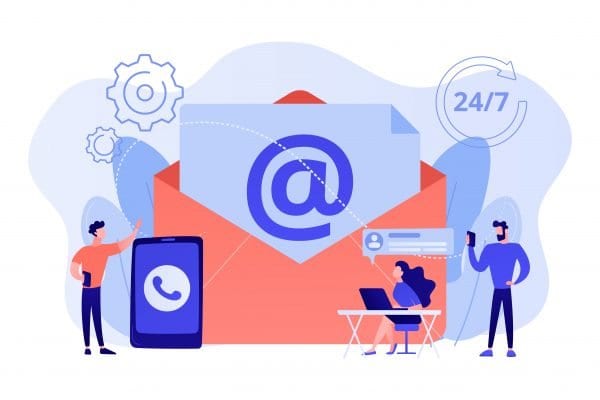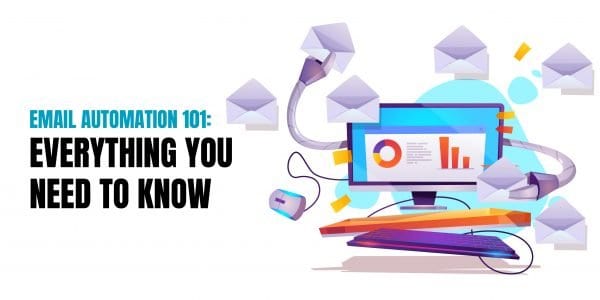Email automation is a powerful tool that can help businesses of all sizes improve their communication with customers and boost their bottom line. By automating repetitive and time-consuming tasks, automation allows businesses to focus on more important things, like growing their customer base and generating revenue. It’s for this reason that 87% of marketers rely on email automation for their customer acquisition and retention efforts.
If you’re new to email automation, don’t worry—it’s easier than you think! In this beginner’s guide, we’ll walk you through the basics of email automation, including what it is, how it works, and how you can use it to benefit your business.
Understanding Email Automation
Email automation refers to the process of using technology to automate the sending of emails based on specific triggers or conditions. This can include things like sending a welcome email to new subscribers, sending an abandoned cart email to customers who left items in their online shopping cart, or sending a re-engagement email to inactive subscribers.
Email automation is different from traditional email marketing, which typically involves sending out a single email or a batch of emails to a large group of people all at once. With email automation, you can create targeted and personalized messages that are sent to specific segments of your email list based on their behavior or engagement with your business.
Setting up Email Automation for Your Business
Identity email campaigns
To start using email automation for your business, the first step is to identify the types of emails that will be most beneficial for your customers. Depending on your industry and target audience, this may include things like welcome emails, abandoned cart emails, re-engagement emails, or post-purchase follow-up emails. We will provide more info on this later on in the article.
Choose an Email Automation Platform
Next, you’ll need to choose an email automation platform. There are a number of options available and it’s important to research and compare different features and functionalities to find the one that best meets the needs of your business. It’s worth noting that some business management software solutions also come with built-in email automation capabilities and can be integrated with other marketing and sales tools for a more streamlined workflow.
Import and Segment Email List
Once you have selected your email automation platform, the next step is to import and segment your email list. This means uploading your email contacts to the platform and then organizing them into different groups or segments based on things like demographics, past purchases, or engagement levels.
Set up Automation Rules and Triggers
After you have your email list set up, it’s time to create and design your email templates. Many email automation platforms come with pre-built templates that you can customize to suit your branding and message. Finally, you’ll need to set up your automation rules and triggers. This will involve deciding when certain emails should be sent, such as when someone subscribes to your list or when they abandon a cart on your website.
Implementing Email Automation Strategies
Now that you have your email automation system set up, it’s time to start implementing different automation strategies to boost your business’s performance. Here are some common examples of email automation strategies that you can use to engage and nurture your customer base:
Welcome email series: Send a series of welcome emails to new subscribers to introduce them to your brand and encourage them to take certain actions, such as making their first purchase or signing up for your loyalty program.
Abandoned cart emails: Send automated emails to customers who have abandoned items in their online shopping cart to remind them of the items they left behind and encourage them to complete their purchases.
Re-engagement campaigns: Send automated campaigns to inactive subscribers to re-engage them with your brand and encourage them to take certain actions, such as making a purchase or signing up for your loyalty program.
Retargeting campaigns: Send automated campaigns to customers who have recently made a purchase to promote related products or services.
Automated email sequences for lead nurturing: Create automated email sequences that nurture leads through the buying journey. The sequence will help to educate the lead about the products or services that you offer, build trust and introduce them to the different stages of the sales funnel.
Post-purchase follow-up emails: Send automated emails to customers after they make a purchase to thank them for their business, ask for feedback and encourage repeat purchases.
It’s important to note that these are just a few examples of the many different email automation strategies that you can use to benefit your business. As you get more comfortable with email automation and understand how your customers interact with your business, you can experiment with different strategies to see which ones work best for you.
Measuring and Optimizing Email Automation
As with any marketing strategy, it’s important to track and analyze the performance of your email automation campaigns. This will allow you to see which campaigns are working well and which ones need to be tweaked or improved. Some key metrics to track include open rate, click-through rate, conversion rate, and unsubscribe rate.
If you notice that certain campaigns are not performing as well as you would like, you can make adjustments and test different strategies to try and improve their performance. This could include testing different subject lines, email designs, or call-to-action buttons. A/B testing allows you to compare two variations of an email, and then send the more successful version to the rest of your list.
Final thoughts
Overall, email automation is a great way to improve the way you communicate with your customers, but it takes time to perfect and make a significant impact. However, with the right approach and by following this beginner’s guide, you can create email campaigns that are tailored to your customers and boost the performance of your business.






